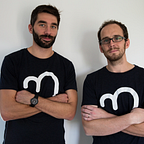When “It’s really cool!” Is Not a Product
Pivoting because positive feedback isn’t enough
Over the past six months, nobody has told us that our product is really cool. Yet they’ve been the best six months in the history of BYM, and we’re going to do everything we can to make sure that nobody ever tells us that we have a cool product again.
Instead, “I can’t tell you what it means to me,” is what we hear from our users now. And that’s what actually counts, both in terms of growing our business and creating relationships.
3 years ago, when we started BYM, we were specialists in biomechanics aiming at high-performance athletes. Our trackers were designed to help them optimize training, give them insights on their bodies’ movements and push them to new heights. We figured all the stars were aligned: these were people who invest in their health, who are young and tech-savvy, who are interested in the information we provide. We tested our system with elite golfers, professional tennis players, talented people across a range of sports. They all said the same thing: “It’s really cool, I like it.”
But that was the end of it. For them, our product was a nice-to-have. Maybe the most obsessive would eventually pay for it, but we found there wasn’t any real relationship between “This is cool,” and “Shut up and take my money!”
Our goal when we launched BYM was to develop things that were useful, that could bring a simple and efficient solution to a problem that mattered. We knew that initial failure could only help us, and we started thinking again about our tool. We realized that instead of just tracking movement, we could actually encourage movement. Where did that matter? Rehab was something that had crossed our minds, but we hadn’t explored it at all.
June 2015, “…so when can we buy it? How much does it cost?”
We started doing that exploration. It meant lots of meetings: physiotherapists, occupational therapists, patients, assistants. We kind of went in blind, with just a mockup of an app sketched on paper after an early meeting with two physiotherapists. We didn’t even know if we’d be able to make it into a product, but hey, we figure being entrepreneurs is exactly that, working hard to find good problems to have. By the end of June 2015, we had our good problem: “When can we have your product? How much does it cost?”
That’s why BYM’s primary focus now is on people who are recovering from a stroke and people suffering from Parkinson’s disease. We went from the young and tech-savvy to an older population who oftentimes has to buy their first tablet to use with our solution. But that population is VERY happy to figure out how use a tablet, because it lets them take back control of their movement.
That’s because the situation they face is extremely difficult: intensive and constant physical therapy is needed, but time at the clinic and with therapists is limited. One of the biggest things that we’ve realized is just how hard it is for those of us who have never had our ability to move taken away to come close to understanding the toll that it takes on you, both physically and mentally. Our solution helps them to recover at home, with just a tracker and a tablet, and in a way that is efficient and fun (at least as fun as rehab possibly can be).
Anybody will tell you that running a startup is hard. And it’s especially hard when you’re bootstrapping a medical device. Medicine is a sector that really brings out emotional reactions. When we talk about BYM, we hear the same thing over and over: “That’s great, you’re doing something to really help people!” But that emotion also blocks people from making critiques, and when you’re building a product, you need critiques. Before you have lots of users, you have to sort out what is just an emotional reaction and what is an objective opinion that matters. You kind of have to become allergic to compliments. For us, it’s the only way to keep that original goal in mind, creating an efficient product that solves a big problem.
So now for us the best thing is opening up our mailbox (our real mailbox!) and seeing that one of our users has sent us back a postcard.
Sure, a postcard might take longer to get to us than an email. But it gives us the most valuable feedback, and let’s be honest, it feels great. People like Léa and Nicolas use our product because it truly makes a difference in the quality of their daily lives.
That human side is one of the biggest rewards. Traveling throughout France, we’ve taken our solution to people who live far from cities where startups are common, we’ve been invited into their homes. They talk to us about how they use BYM, they help us to improve the product, they give us tea and cookies. And we can’t tell you how good it is to not hear “It’s so cool!” anymore, but instead to hear just “Merci — merci beaucoup.”
Is BYM something that could make a difference for you or a loved one? Have suggestions for how we can make it even more useful? Let us know at contact@bymlife.com
